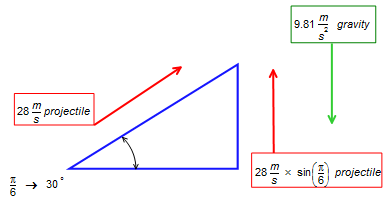If a projectile is shot at an angle of #pi/6# and at a velocity of #28 m/s#, when will it reach its maximum height??
1 Answer
Maximum height after release is achieved in approximately
Explanation:

Note that
Let upwards velocity be positive and due to initial projectile force
Let downward velocity be negative and due to gravity
Let time in seconds be
Let time at maximum height be
Let the unit second be represented as
Let the unit distance be represented by
Acceleration due to gravity is
Assumption: there is no drag or any other forces involved
The maximum height is when upward velocity equals downward velocity
Downward velocity at any instant
Maximum height is achieved at
Thus

